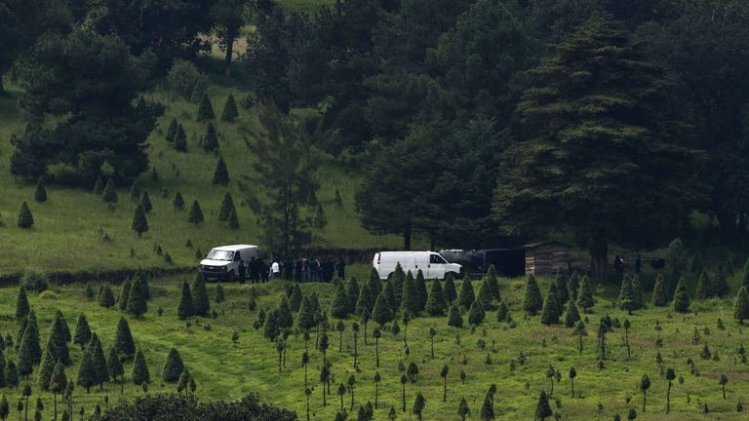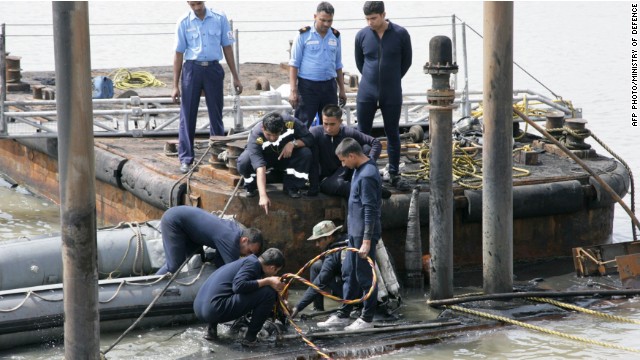A plan to use DNA to identify the remains of sailors and Marines killed in the Pearl Harbor attack has caused a split within the military community over what to do with the remains of thousands of unknown service members from the wars of the mid-20th century.
Should these bodies be dug up and returned home, at considerable cost, to places like Cozad, Bloomfield and Central City, Neb., in keeping with the sentiment “no one left behind”? Or should they be left in their decades-old resting places far from home?
Thanks to DNA technology and an injection of cash from Congress, there's a plan to identify the remains of nearly 400 “unknown” sailors and Marines from the battleship USS Oklahoma, torpedoed and sunk in the first minutes of the Dec. 7, 1941, attack on Pearl Harbor in Hawaii. Seventeen of the sailors are from Nebraska and western Iowa.
The task likely would take place at a giant new military forensics lab at Offutt Air Force Base.
The logistics would be daunting. Most of the Pearl Harbor dead were entombed anonymously, their remains mingled with those of their shipmates. They are scattered in dozens of modest group tombs throughout Honolulu's famous Punchbowl cemetery, remote from their families.
A single USS Oklahoma grave opened in 2003 yielded five identifiable sets of remains, each returned to grateful families and buried with full military honors.
“These towns are eager to get these kids back, and honor them,” said Paul Goodyear, 95, president of the USS Oklahoma Association and a Pearl Harbor survivor. “They go all out. You'd have thought it was Independence Day.”
The Navy has proposed forming a working group, representing several military commands involved in finding and identifying unknown remains, to make decisions about the Oklahoma dead. What that group does could set a precedent for other group remains.
The job of identifying the Pearl Harbor dead has fallen to the Joint POW/MIA Accounting Command. A precursor of the command was formed 20 years ago and assigned the permanent job of finding and identifying missing service members from the Vietnam War. Later, Congress asked it to search for those lost during the Korean and Cold Wars, and for World War II air crews lost in the Pacific.
Some veterans say JPAC long resisted veterans' pleas to identify some of the hundreds of unknowns buried just a few miles from its Honolulu headquarters in the Punchbowl, an extinct volcano converted to the National Memorial Cemetery of the Pacific after World War II.
“They've got these kids right under their noses, and they won't dig them up,” Goodyear complained.
The Joint POW/MIA Accounting Command public affairs office didn't respond to four requests over the past two weeks for an interview with senior JPAC leaders.
A Government Accountability Office audit released in June said the Defense Department didn't assign the job of identifying World War II veterans other than Pacific air crews until 2009.
In that year, Congress substantially boosted the Joint POW/MIA Accounting Command budget, which had jumped from $51 million in 2008 to nearly $100 million four years later, and ordered it to boost its identifications from about 70 per year to 200 by 2015.
Traditionally JPAC had focused on complex and costly archaeological excavations in Korea, Southeast Asia and the South Pacific. The new quota and expanded mission made the command more receptive to opening the graves of the unknowns from the Oklahoma. John Byrd, director of JPAC's Central Identification Laboratory, recently told the Oklahoman newspaper of Oklahoma City he thought at least three-quarters of the ship's dead could be identified using DNA technology.
Accordingly, the Joint POW/MIA Accounting Command has requested permission to open all of the graves from the Oklahoma, as well as graves at the Punchbowl containing smaller numbers of bones linked to the Pearl Harbor battleships California (100 dead) and West Virginia (66 dead). The decision is up to the Army, which holds authority over the graves of all unknowns.
JPAC's plan has run into opposition from the Navy. Officials there have said they don't like the idea of exposing long-buried remains “outside of the sanctity of the grave” for an accounting that could take years and still leave many remains unidentified. The Navy has no authority in the matter, but voices concern because the single grave that was opened in 2003 yielded not only the five identified sailors but also the bones of about 100 more that aren't yet identified and remain in JPAC's lab.
Lt. Cmdr. Sarah Flaherty said the Navy hopes to re-inter those remains in a ceremony on Dec. 7, 2014. They're seeking the Army's support.
“(The Navy) maintains any ID effort will take many years, if not decades,” Flaherty said. “A memorial ceremony in the near future offers temporary closure and a cogent place for survivors to treat as a final resting place in the interim.”
The conflict sheds light on the troubled history of the Oklahoma's remains.
For months after the attack, the Oklahoma remained overturned in the shallow channel next to Ford Island, right where the battleship USS Missouri is now moored.
Between July 1942 and November 1943, the Navy worked to right the ship. According to author Jeff Phister's 2008 book, “Battleship Oklahoma BB-37,” as divers recovered bodies from the ship, they were bagged, with the skull separate from other remains for future identification using dental records. They were placed in flag-draped coffins and moved to shore on barges as Marine honor guards stood at attention.
The remains were buried in two Honolulu cemeteries until after the war. Then the American Graves Registration Service dug up the bodies in hopes of identifying them.
What they found instead was a tangled mess of oil-soaked bones, hopelessly mixed up and nearly impossible to identify, according to a history compiled in 2010 by military historian Heather Harris.
Twenty-seven skulls were identified from dental remains and placed with torsos, arms and legs drawn from the rest of the remains. Plans were discussed to return those reconstructed skeletons to their families.
But Dr. Mildred Trotter, a pioneer in the field of forensic anthropology who was hired to oversee the process, recoiled at the idea, according to a May 1949 memo Harris discovered in Trotter's papers after her death.
Officials in Hawaii and Washington argued over how to rebury the remains. The American Graves Registration Service considered returning just the skulls to the families, but decided it was wrong to return partial remains.
Finally, the bones were segregated by body part, with skulls buried together, arms together, legs together, and so forth, and placed in plots scattered throughout the Punchbowl.
There they might have rested permanently if Ray Emory, a Pearl Harbor survivor, had not retired to Hawaii in the mid-1980s.
Soon after his arrival, he trekked up to the Punchbowl.
“I wanted to know where the Pearl Harbor grave sites were,” Emory, now 92, recalled in a phone conversation last week. “They couldn't tell me.”
He walked the cemetery repeatedly and found dozens of graves marked “Unknown, Dec. 7, 1941.” Through documents acquired using the Freedom of Information Act, he began a years-long process of assembling clues to find who the missing dead might be, and in which graves they might lie. “It was like a jigsaw puzzle,” Emory said. He found out about the 27 skulls that had been identified in 1949, and he traced some of them to individual graves. His work led to the addition in 2002 of ship names to many of the unknowns' grave markers. And his prodding led the Joint POW/MIA Accounting Co
mmand to open the single grave in 2003. The divisions within the military are reflected in the families, too.
Sheri Spomer, 41, wants to see her uncle Gerald Clayton buried next to his parents in his hometown of Central City. Clayton was a 21-year-old storekeeper second-class the day he died aboard the Oklahoma.
“There was nothing dignified in the way the Navy handled the burial of my uncle and all those other men. They deserve more than being buried together as 'unknown,' ” Spomer said. “They were not unknown to their families, and they certainly have not been forgotten.”
Eva Maule, 92, of Bloomfield, said the family of her late husband, Donald, put a marker in the local cemetery to honor his brother, Joseph Maule, who died aboard the Oklahoma, even though his body was never recovered. She doesn't see any need for a big fuss now.
“To my notion, I think they should leave all the bones buried there,” she said.
Jean Cook Sheehan, 90, was close to her brother, Grant Cook Jr., who was two years older. Their mother died when both were babies. An aunt and uncle raised them in their hometown of Cozad.
She said Grant quit his job at a garage in 1940 to join the Navy and find adventure. That's how he landed in Pearl Harbor.
Sheehan learned of the attack after coming home from a Sunday movie matinee. She shared the nation's numb horror, and feared for her brother.
“When I heard my brother was missing — just complete shock, so much sadness,” said Sheehan, who now lives in Lecanto, Fla. “It was hard for us to believe that he really was gone.”
She said her father never forgave himself for signing the papers that allowed his son and namesake to enlist before he was 21.
She has mixed feelings about unsealing the Oklahoma graves. At her age, she doesn't imagine returning to Cozad to visit even if he were to come back. The VFW post that carries his name seems like a fitting memorial.
“From what I understand, the remains are in an absolutely beautiful place. One thought is, why disturb them?” she said. “On the other hand, it would be nice to know that, if they are identified, he is back home.”
In recent years, no one has spent more time talking with Oklahoma families than Dee Dee King, a Texas-based forensic genealogist hired by JPAC in 2009 to find the next of kin and ask for DNA samples that might help identify the unknowns. She has found the families of all but eight.
She said the losses are surprisingly fresh, more than 70 years after Pearl Harbor.
“Some of these people have the most heartbreaking stories to tell,” she said.
The Facebook page for her company, Forensic Genealogists, features the eternally youthful photos of the Oklahoma sailors. She feels a connection to them.
“These guys want to be found,” King said. “I just know it.”
Sunday 25 August 2013
http://www.omaha.com/article/20130825/NEWS/130829306/1685



